
|
"The art of teaching is the art of assisting discovery"
|

|

|
"The art of teaching is the art of assisting discovery"
|

|
My Fingerloop Loom | Methods of Making Long Fingerloop Braids | Info and How Tos
My Fingerloop Braiding Loom, No Beater | One Person and No Beater | Two People and a Movable Beater | One Person and a Fixed Beater

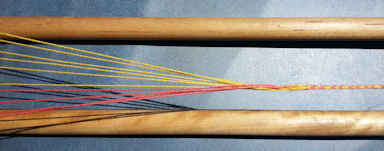
|
Detail Photos of My LoomWhen I first learned to fingerloop braid, I was frustrated by the length limit imposed by only being able to tighten the braiding by spreading your arms to either side. Trying to do a long braid means having a very loose braid at the beginning. So I went home and looked for a way to make longer braids. I found a long "indian beading loom" a friend had made for me and things clicked! The other frustrating thing about fingerloop braiding for me was that, once started, you have to keep braiding until you're done. Otherwise the loops (or bowes) get tangled and your braid is ruined. A very useful thing about using the beading loom is that it has springs that hold the beading's warp threads, the spring at the front of the loom is ideal for holding the loops of thread when I want to put the braiding down for a bit. Go to my Loom page for Photos details of my Loom |
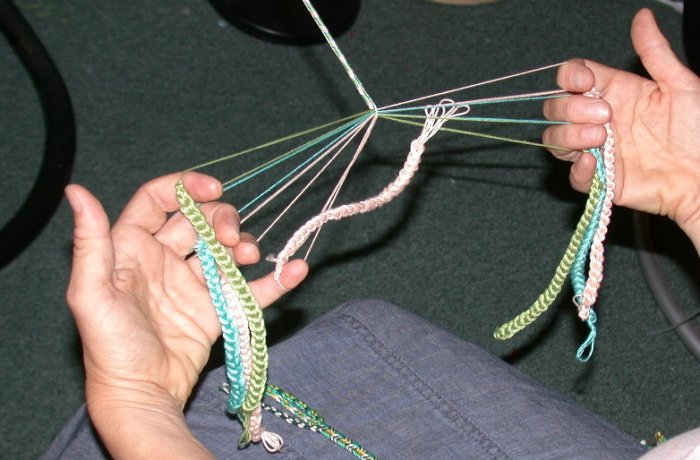
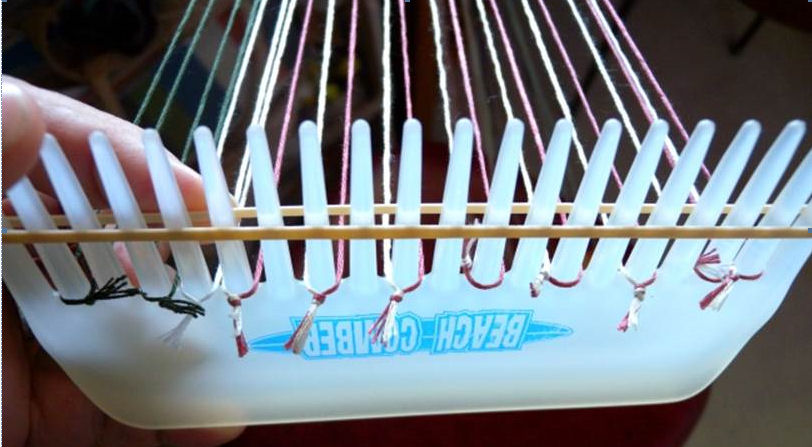
Photos © Ingrid Crickmore |
Loop Braiding: Longer loop braids, and starts with no endsThis website has some very cool ideas! One of the methods she uses is very like my loom, but WITHOUT a loom! For that method, she crochets the extra cord in a chain that sits at the back of the loop (like my bobbins) and is dragged through the loops as you braid.
She also has a great way of keeping the threads in order when not in use (instead of the spring I use): She parks them between the teeth of a large comb and keeps thm in place with a rubber band!
But the method she recommends that you use is the Center Start method ... start in the the center, braid to one end, go back to the center and braid to the other end. SIMPLE and (now that she mentions it) obvious! I should have thought of that when I was looking for a long braiding method!
Her methods are wonderfully portable and easy to put together! Go to her webpage and check it out!!!! |
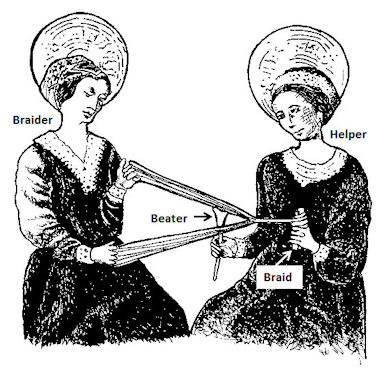 |
"One braider and helper pictured in 1465 CE, from the Spanish altar
piece "Historia de la Virgen Maria," attributed sometimes to Nicolas de Zahortiga."
-- Fingerloop Braids by
Mistress Rhiannon y Bwa (Lois Swales) & Mistress Azza al-Shirazi (Zoe Kuhn Williams)
The woman on the right is taking care of beating the braid with the stick in her right hand, and rolling up the completed braid on the stick in her left hand. She would start at a distance from the braider (woman on the left) and, winding finished cord onto the holder in her left hand, gets closer as the braid was completed. The illustration is a bit misleading, once the unbraided cord was this short the helper doesn't need to be beating the braid, the braider can do at this point by spreading her arms to tighten the braiding.
A full version of this painting can be found in: Drgens Sn Wir Vs
Nvt Schame - No Shame In Braiding 15th CEentury Fingerloop Braids From Lengberg Castle by Beatrix Nutz
A video of this method can be found in this
You Tube video of Wayúu women working fingerloop braiding (at 2:25 in the video").
They have tied the braid to a post and the helper moves the point of braiding to the finished cord and
tightens it down.
|
 |
"Copy from the reproduction by Taschen, Köln, Germany, 1997, of "Descriptiion de l'Egypte /
publiée des ordres of Napoléon Bonaparte," published 1809. Copyright Bibliothèque Sainte Geneviéve,
Paris, France." -- L-M BRIC News issue #6, {on the Wayback Machine} section titled:
"Loop-braiding in Early 19th-c. Egypt" © Masako Kinoshita
The braiding stand includes a round weight (far right hand side) that the braid is connected to, that weight would pull the completed braid away from the braider. As the braider works, he pulls the cords toward him, beating the braiding down the cord with the nail(?) attached to the front of the stand (left hand side). As with the 2 people method, the braider would staet out far away from the end of the stand and move closer as the cord is worked, so that the point of braiding stayed just behind the beater. He'd raise his hands as he braided so that the cord was ABOVE the top of the beater, then lower the cord (with the point of braiding BEHIND the beater) to beat the braiding down the cord. Pretty slick acutally, you can see the smooth movenments:
|
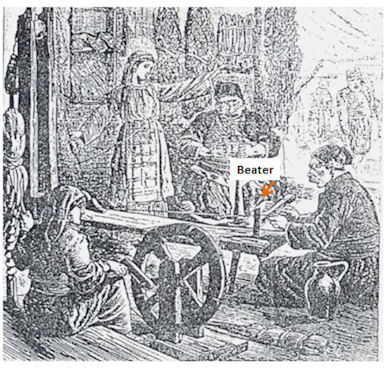 |
"Bulgaria in the late 19th c." -- L-M BRIC News issue #6, {on the Wayback Machine} section titled: "Loop-braiding in Early 19th-c. Egypt" © Masako Kinoshita
Just like the German print, this stand has a beater on the front of the stand (right hand side). It's hard to see the back end of the loom (left hand side), but it seems like it would also has a weight to take up the finished braid. |
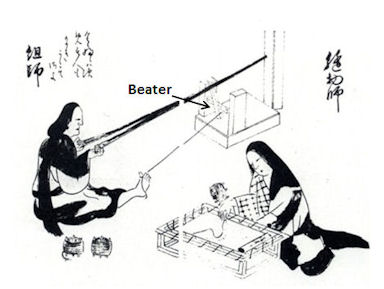 |
"As the Japanese answer to the problem, the one illustrated in a 15th-c.
Scroll is called heshiki (pusher), and another in a 17th-c. encychropedia, which is essentially the
same device, is called ashiuchidai (foot beater stand). The sword-shaped beater is connected to the
braider's ankle by a rope and beats the fell whenever a foot motion pulls other end of the rope tied
to the braider's ankle. Details of the working mechanism for advancing the fell to adjust it to the
point of impact, however, cannot be discerned so far from any of illustrations, although constructing
a workable beater may not be difficult" --
L-M BRIC News issue #6, {on the Wayback Machine} section titled: "Loop-braiding in
Early 19th-c. Egypt" © Masako Kinoshita
This one is interesting, I like the movable beater! And I love the ankle/foot cord for activating the beater!! But I can't tell how the completed braid is handled.
|